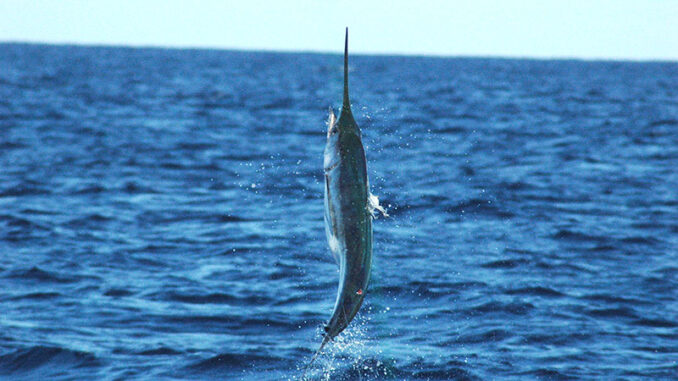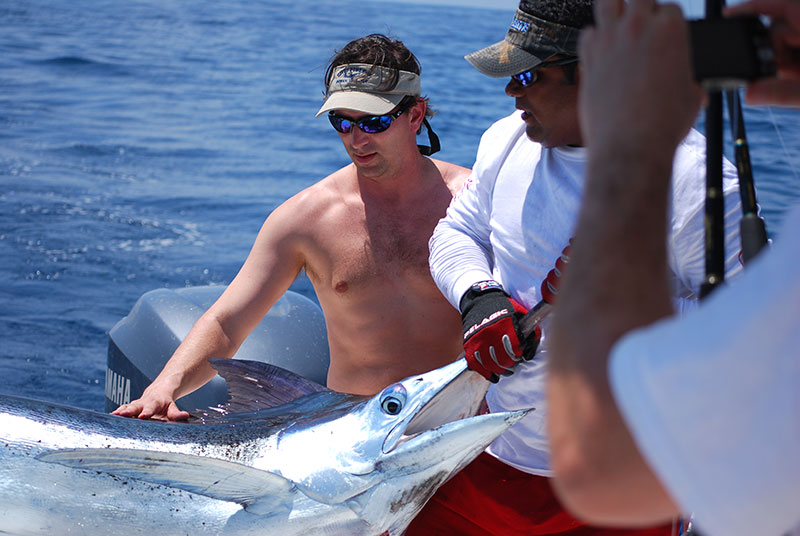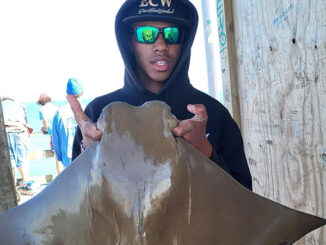
I hear excuses all the time of why some fishermen, even those that spend a lot of time in the blue water, don’t go and try to catch a blue marlin. In my semi-informed opinion, anyone who is making an excuse not to target the king of the ocean falls into one of two categories. Either they have never tried it before, or they have tried it and not had any success. If they had ever had a good day marlin fishing, they would be singing another tune entirely.
Capt. Wade Fickling, of Morehead City, summed it up the best I’ve ever heard years ago when he told me: “I’ve been fishing for a living for all my adult years. I’ve caught at least one of anything worth catching. Blue marlin are the only fish in the ocean that still make my knees knock when I see one.”
I just don’t think it can be put any more eloquently than that. So I’m not going to try.
For most of us saltwater anglers in North and South Carolina, May is the absolute best month to try and specifically target a blue marlin. This is especially true if you fish anywhere south of the Outer Banks, where the season generally comes a bit later, but can still be productive in May. Many anglers, though, are unaware of three things.
Go deep
First, blue marlin can be successfully hooked and released from boats much smaller than the average diesel-powered charter boat. Second, it doesn’t require a degree in marine biology or a paid crew member that fishes 200 plus days a year to have success in this game. Finally, while I’ll admit that you’re going to spend a bit more money in fuel than a day of fishing for tuna, dolphin, or wahoo, it’s not that much more. You’re already going to the break. At that point, what’s 10 or 15 more miles? Even the “bycatch” out in blue marlin country (100+ fathoms of water with any bottom contour or structure at all is in play) can be excellent.
Most of the citation dolphin I have caught came on marlin-oriented trips, and there is always a monster wahoo or two out roaming the deep, just waiting to crash a marlin bait.
Before I get sued by someone trying to take their 14-foot skiff and enter it in a blue marlin tournament, here is my disclaimer. I would personally have absolutely no issue going blue marlin fishing in a 25-foot center console (even one with a single 4-stroke outboard) that I was familiar with, provided I was certain that it was well-built, well-equipped, and in good operating condition, on a good weather day. That’s my own personal line.
You must know your own boat and your capabilities as a captain. If you are not comfortable with making the trip, then, don’t do it. If the forecast is iffy, try it another time. But if you are comfortable, and the weather is right, then please, read on.
Gear up
Obviously, you need stout rods and good reels to catch a blue marlin. Even a small blue will expose any flaw in your tackle setup. You must also remember that very few center console boats have fighting chairs. You are generally going to be fighting a fish standing up in the bow in this scenario, chasing the fish with the boat.
The best compromise I have found is an 80-pound class rod with a gold 50W reel. I put 300 yards of braid on the reel as a “warning track” and the rest of the reel is filled with 80-pound mono. Out of a fighting chair, I would probably opt for the 80-pound class reels, but they are simply too heavy to stand up with for long.
Skipping any fancy connections, I put a Bimini twist at the end of each line and loop on a heavy snap swivel. All leaders are made of Momoi X-Hard mono, cut to 25 feet. I use 300-pound on the small lures and 400-pound on anything bigger. I only use single hooksets on stainless cable for blue marlin. Double hooksets can kill these magnificent fish much more easily than singles, and I have no desire to do that. When you see your first one jump, you’ll understand. It’s a simple setup, but believe me, it works.
A five-rod spread is all you really need to have a shot at a blue marlin. From a center console, it’s easy to troll five rods, and to troll them correctly. Don’t worry about teasers, dredges, or anything fancy. Just pull five plugs.
I have always been a fan of the hard resin head plugs versus any kind of soft marlin lure. That is just personal preference. A ton of blue marlin have been caught in the Carolinas on Moldcraft Wide-Range Heads and Pakula Sprockets, but never by me.

I have always had success with the Black Bart line of plugs, along with Fathom and Bahama Lure. I will state for the record that my top-performing blue marlin lure of all time is Bart’s Cairns Prowler Jet, which makes absolutely no sense until I tell you that I always have one out there in a rigger position when I’m blue marlin fishing, as it was the first lure I ever caught a blue marlin on. It’s not rocket science. There’s always a 20 percent chance that it is the one that gets bit.
Put a spread of five lures behind the boat that you like and think will be visually appealing to the fish. Initially, yes, the cost to buy a spread of lures is a lot more than a couple of packs of ballyhoo. Some of my lure collection has been with me for 20 years and multiple fish caught. Plugs are reusable. Ballyhoo aren’t.
Stay ready
To be a bit more technical, I want two bigger lures, with bigger actions on the corner rods (flat lines) where I’m not limited at all by the smaller outriggers found on most center console setups. A Bart 1656 Angle Head and a Bahama Lure Prometheus are my go-to plugs here. I run a smaller, straight running plug farther back as a “stinger.”
The corner rods and the stinger rod have their lines clipped down with No. 64 rubber bands (sometimes) multiple when I like the way that they are running. I want to see the lures coming down the front of the swell when I’m trolling down-sea. I run two smaller plugs (including my beloved Cairns Prowler Jet) from the outriggers, with the line simply running through the release pin. When it looks right, I leave it as it is. All I want now is the explosion behind the boat and to hear the reel scream.
When that magical bite does come, you’re going to know what it is just about immediately. Either the reel will empty at a rate you have never seen before, or you’ll have a blue marlin jumping behind the boat. Get a standup belt on your angler and get them into the bow. Crank the rest of the spread in. You’re chasing the fish down, driving the boat to the fish. Go slow enough to keep the line tight but be ready to throttle up if line starts disappearing faster than you like. Enjoy the fight. To a good many, this is the apex of big game fishing.
When the fish tires, only then do you want the angler behind the helm, in one of the corners. I like to keep a tired blue marlin down sea of the boat, at an angle, to reduce the possibility of hitting the fish with a prop. If I’m on wireman’s duty, I put on welding gloves, go slow, and never overlap any wraps I take around my palms, just in case the fish has one last run in it.
When close enough, I’ll grab the bill of the marlin, but far enough up that my hands don’t end up in its mouth. If possible, I want to get the hook out to increase the odds that the fish survives.
After the hook is out, while everyone else is taking pictures, I keep my hands on its bill with the boat moving forward to get water running over the marlin’s gills again. Most of the time they will let you know when they are ready to go and it’s a simple matter of watching them swim off with a few flicks of that massive tail.
The first time I ever saw this in person made me realize I don’t care how they may or may not taste. I lost my desire to ever eat one of these incredible fish.
Go get ‘em:
Trolling for blue marlin isn’t vastly different from trolling for dolphin or wahoo, but it does usually require a slightly longer commute to the best billfish waters available. And you can still catch plenty of dolphin and wahoo while trying for marlin.




Be the first to comment